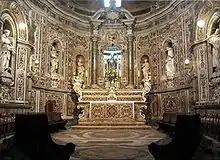Catald
Saint Catald of Taranto (a.k.a. Cataldus, Cathaluds, Cathaldus, Cat(t)aldo, Cathal), Irish monk, fl. 7th century.[2]
Saint Catald | |
|---|---|
_(Taranto).jpg.webp) Statue of Saint Catald at Taranto. | |
| Born | 7th century [1] Ireland |
| Died | 685 Taranto |
| Venerated in | Tarento, Ireland |
| Canonized | About 685 (Pre-congregation) |
| Major shrine | Lismore, County Waterford, Taranto |
| Feast | 10 May |
| Patronage | Invoked for protection from plagues, droughts and storms |
Biography
His monastery was in Lismore, County Waterford but his apparent desire for a life of solitude saw him venture off to Jerusalem on a pilgrimage.

On his return home his ship was wrecked off the Italian coast, near the city of Taranto. The people here appear to have encouraged the monk to become their bishop, and he rose to become their archbishop. Some of the miracles claimed in Catald's name include protecting the city against the plague and floods that, apparently, had occurred in neighbouring areas.
When his coffin was reopened it allegedly contained a golden Celtic cross and a stick carved from Irish oak featuring Celtic design which was to become Catald's emblem.
Legacy
The Italian towns of San Cataldo (there is such a town in Sicily, and a modern sea resort in the Apulian Province of Lecce) are believed to have been named in his honour, and his feast day is 10 May.
Saint Cathal was the patron of the Sicilian Normans.[3]
The parish church in Montenero Sabino, province of Rieti, in the region of the Lazio, is dedicated to San Cataldo.
See also
References
- https://www.facebook.com/photo.php?fbid=1180665815299595&set=a.148689931830527&type=3&theater
- https://www.facebook.com/photo.php?fbid=1180665815299595&set=a.148689931830527&type=3&theater
- Jerome Murphy-O'Connor (2008). The Holy Land: An Oxford Archaeological Guide from Earliest Times to 1700. Oxford Archaeological Guides. Oxford: Oxford University Press. ISBN 978-0-19-923666-4. Retrieved 10 April 2018.
External links
| Wikimedia Commons has media related to Saint Cataldus. |